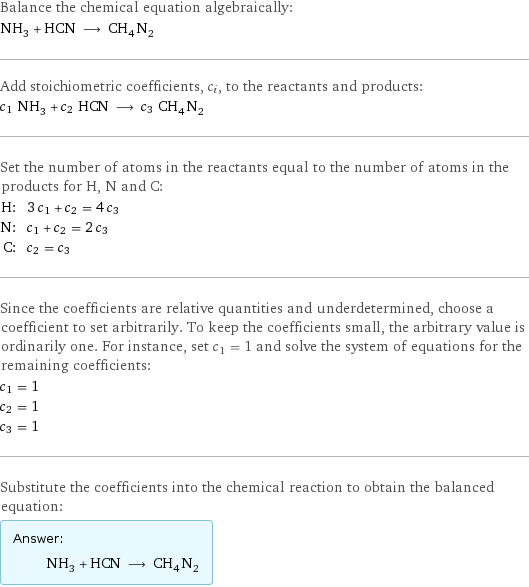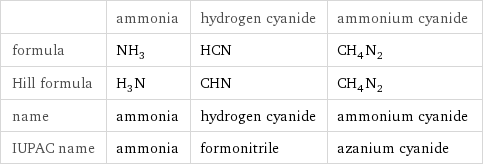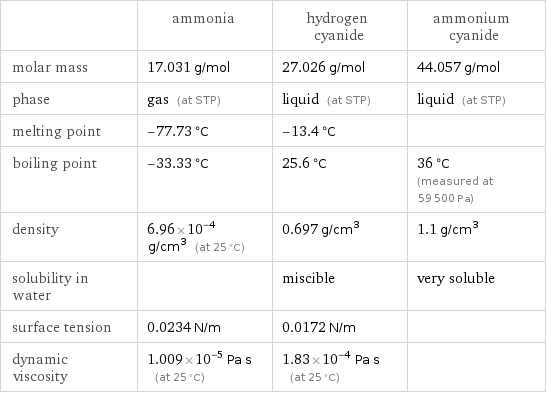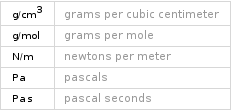Input interpretation

NH_3 ammonia + HCN hydrogen cyanide ⟶ CH_4N_2 ammonium cyanide
Balanced equation

Balance the chemical equation algebraically: NH_3 + HCN ⟶ CH_4N_2 Add stoichiometric coefficients, c_i, to the reactants and products: c_1 NH_3 + c_2 HCN ⟶ c_3 CH_4N_2 Set the number of atoms in the reactants equal to the number of atoms in the products for H, N and C: H: | 3 c_1 + c_2 = 4 c_3 N: | c_1 + c_2 = 2 c_3 C: | c_2 = c_3 Since the coefficients are relative quantities and underdetermined, choose a coefficient to set arbitrarily. To keep the coefficients small, the arbitrary value is ordinarily one. For instance, set c_1 = 1 and solve the system of equations for the remaining coefficients: c_1 = 1 c_2 = 1 c_3 = 1 Substitute the coefficients into the chemical reaction to obtain the balanced equation: Answer: | | NH_3 + HCN ⟶ CH_4N_2
Structures

+ ⟶
Names

ammonia + hydrogen cyanide ⟶ ammonium cyanide
Equilibrium constant
![Construct the equilibrium constant, K, expression for: NH_3 + HCN ⟶ CH_4N_2 Plan: • Balance the chemical equation. • Determine the stoichiometric numbers. • Assemble the activity expression for each chemical species. • Use the activity expressions to build the equilibrium constant expression. Write the balanced chemical equation: NH_3 + HCN ⟶ CH_4N_2 Assign stoichiometric numbers, ν_i, using the stoichiometric coefficients, c_i, from the balanced chemical equation in the following manner: ν_i = -c_i for reactants and ν_i = c_i for products: chemical species | c_i | ν_i NH_3 | 1 | -1 HCN | 1 | -1 CH_4N_2 | 1 | 1 Assemble the activity expressions accounting for the state of matter and ν_i: chemical species | c_i | ν_i | activity expression NH_3 | 1 | -1 | ([NH3])^(-1) HCN | 1 | -1 | ([HCN])^(-1) CH_4N_2 | 1 | 1 | [CH4N2] The equilibrium constant symbol in the concentration basis is: K_c Mulitply the activity expressions to arrive at the K_c expression: Answer: | | K_c = ([NH3])^(-1) ([HCN])^(-1) [CH4N2] = ([CH4N2])/([NH3] [HCN])](../image_source/00ac6b25bcff5a7a5961bb8000acaac4.png)
Construct the equilibrium constant, K, expression for: NH_3 + HCN ⟶ CH_4N_2 Plan: • Balance the chemical equation. • Determine the stoichiometric numbers. • Assemble the activity expression for each chemical species. • Use the activity expressions to build the equilibrium constant expression. Write the balanced chemical equation: NH_3 + HCN ⟶ CH_4N_2 Assign stoichiometric numbers, ν_i, using the stoichiometric coefficients, c_i, from the balanced chemical equation in the following manner: ν_i = -c_i for reactants and ν_i = c_i for products: chemical species | c_i | ν_i NH_3 | 1 | -1 HCN | 1 | -1 CH_4N_2 | 1 | 1 Assemble the activity expressions accounting for the state of matter and ν_i: chemical species | c_i | ν_i | activity expression NH_3 | 1 | -1 | ([NH3])^(-1) HCN | 1 | -1 | ([HCN])^(-1) CH_4N_2 | 1 | 1 | [CH4N2] The equilibrium constant symbol in the concentration basis is: K_c Mulitply the activity expressions to arrive at the K_c expression: Answer: | | K_c = ([NH3])^(-1) ([HCN])^(-1) [CH4N2] = ([CH4N2])/([NH3] [HCN])
Rate of reaction
![Construct the rate of reaction expression for: NH_3 + HCN ⟶ CH_4N_2 Plan: • Balance the chemical equation. • Determine the stoichiometric numbers. • Assemble the rate term for each chemical species. • Write the rate of reaction expression. Write the balanced chemical equation: NH_3 + HCN ⟶ CH_4N_2 Assign stoichiometric numbers, ν_i, using the stoichiometric coefficients, c_i, from the balanced chemical equation in the following manner: ν_i = -c_i for reactants and ν_i = c_i for products: chemical species | c_i | ν_i NH_3 | 1 | -1 HCN | 1 | -1 CH_4N_2 | 1 | 1 The rate term for each chemical species, B_i, is 1/ν_i(Δ[B_i])/(Δt) where [B_i] is the amount concentration and t is time: chemical species | c_i | ν_i | rate term NH_3 | 1 | -1 | -(Δ[NH3])/(Δt) HCN | 1 | -1 | -(Δ[HCN])/(Δt) CH_4N_2 | 1 | 1 | (Δ[CH4N2])/(Δt) (for infinitesimal rate of change, replace Δ with d) Set the rate terms equal to each other to arrive at the rate expression: Answer: | | rate = -(Δ[NH3])/(Δt) = -(Δ[HCN])/(Δt) = (Δ[CH4N2])/(Δt) (assuming constant volume and no accumulation of intermediates or side products)](../image_source/fb4089131a181bd79ee5ce1de0e36b5e.png)
Construct the rate of reaction expression for: NH_3 + HCN ⟶ CH_4N_2 Plan: • Balance the chemical equation. • Determine the stoichiometric numbers. • Assemble the rate term for each chemical species. • Write the rate of reaction expression. Write the balanced chemical equation: NH_3 + HCN ⟶ CH_4N_2 Assign stoichiometric numbers, ν_i, using the stoichiometric coefficients, c_i, from the balanced chemical equation in the following manner: ν_i = -c_i for reactants and ν_i = c_i for products: chemical species | c_i | ν_i NH_3 | 1 | -1 HCN | 1 | -1 CH_4N_2 | 1 | 1 The rate term for each chemical species, B_i, is 1/ν_i(Δ[B_i])/(Δt) where [B_i] is the amount concentration and t is time: chemical species | c_i | ν_i | rate term NH_3 | 1 | -1 | -(Δ[NH3])/(Δt) HCN | 1 | -1 | -(Δ[HCN])/(Δt) CH_4N_2 | 1 | 1 | (Δ[CH4N2])/(Δt) (for infinitesimal rate of change, replace Δ with d) Set the rate terms equal to each other to arrive at the rate expression: Answer: | | rate = -(Δ[NH3])/(Δt) = -(Δ[HCN])/(Δt) = (Δ[CH4N2])/(Δt) (assuming constant volume and no accumulation of intermediates or side products)
Chemical names and formulas

| ammonia | hydrogen cyanide | ammonium cyanide formula | NH_3 | HCN | CH_4N_2 Hill formula | H_3N | CHN | CH_4N_2 name | ammonia | hydrogen cyanide | ammonium cyanide IUPAC name | ammonia | formonitrile | azanium cyanide
Substance properties

| ammonia | hydrogen cyanide | ammonium cyanide molar mass | 17.031 g/mol | 27.026 g/mol | 44.057 g/mol phase | gas (at STP) | liquid (at STP) | liquid (at STP) melting point | -77.73 °C | -13.4 °C | boiling point | -33.33 °C | 25.6 °C | 36 °C (measured at 59500 Pa) density | 6.96×10^-4 g/cm^3 (at 25 °C) | 0.697 g/cm^3 | 1.1 g/cm^3 solubility in water | | miscible | very soluble surface tension | 0.0234 N/m | 0.0172 N/m | dynamic viscosity | 1.009×10^-5 Pa s (at 25 °C) | 1.83×10^-4 Pa s (at 25 °C) |
Units
